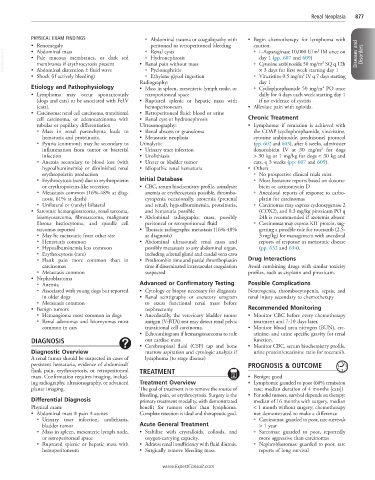Page 1745 - Cote clinical veterinary advisor dogs and cats 4th
P. 1745
Renal Neoplasia 877
PHYSICAL EXAM FINDINGS ○ Abdominal trauma or coagulopathy with • Begin chemotherapy for lymphoma with
peritoneal or retroperitoneal bleeding
• Renomegaly ○ Renal cysts caution. 2
VetBooks.ir • Pale mucous membranes, or dark red • Renal pain without mass ○ Cytosine arabinoside 50 mg/m SQ q 12h Diseases and Disorders
○ L-Asparaginase 10,000 U/m IM once on
• Abdominal mass
○ Hydronephrosis
day 1 (pp. 607 and 609)
2
membranes if erythrocytosis present
• Abdominal distention ± fluid wave
× 3 days for first week starting day 1
2
○ Ethylene glycol ingestion
• Shock (if actively bleeding) ○ Pyelonephritis ○ Vincristine 0.5 mg/m IV q 7 days starting
Radiography: day 1
Etiology and Pathophysiology • Mass in spleen, mesenteric lymph node, or ○ Cyclophosphamide 50 mg/m PO once
2
• Lymphoma may occur spontaneously retroperitoneal space daily for 4 days each week starting day 1
(dogs and cats) or be associated with FeLV • Ruptured splenic or hepatic mass with if no evidence of cystitis
(cats). hemoperitoneum • Alleviate pain with opioids.
• Carcinoma: renal cell carcinoma, transitional • Retroperitoneal fluid: blood or urine
cell carcinoma, or adenocarcinoma with • Renal cyst or hydronephrosis Chronic Treatment
tubular or papillary differentiation Ultrasonography: • Lymphoma: if remission is achieved with
○ Mass in renal parenchyma leads to • Renal abscess or granuloma the COAP (cyclophosphamide, vincristine,
hematuria and proteinuria. • Metastatic neoplasia cytosine arabinoside, prednisone) protocol
○ Pyuria (common); may be secondary to Urinalysis: (pp. 602 and 603), after 6 weeks, administer
2
inflammation from tumor or bacterial • Urinary tract infection doxorubicin IV at 30 mg/m for dogs
infection • Urolithiasis > 30 kg or 1 mg/kg for dogs < 30 kg and
○ Anemia secondary to blood loss (with • Ureter or bladder tumor cats, q 3 weeks (pp. 607 and 609).
hypoalbuminemia) or diminished renal • Idiopathic renal hematuria • Others
erythropoietin production ○ No prospective clinical trials exist.
○ Erythrocytosis (rare) due to erythropoietin Initial Database ○ Most literature reports based on doxoru-
or erythropoietin-like secretion • CBC, serum biochemistry profile, urinalysis: bicin or actinomycin D
○ Metastasis common (16%-48% at diag- anemia or erythrocytosis possible, thrombo- ○ Anecdotal reports of response to carbo-
nosis, 61% at death) cytopenia occasionally, azotemia (prerenal platin for carcinomas
○ Unilateral or (rarely) bilateral and renal), hypoalbuminemia, proteinuria, ○ Carcinomas may express cyclooxygenase 2
• Sarcoma: hemangiosarcoma, renal sarcoma, and hematuria possible (COX2), and 0.3 mg/kg piroxicam PO q
leiomyosarcoma, fibrosarcoma, malignant • Abdominal radiographs: mass, possibly 24h is recommended if azotemia absent
fibrous histiocytoma, and spindle cell peritoneal or retroperitoneal fluid ○ Carcinomas may express KIT protein, sug-
sarcomas reported • Thoracic radiographs: metastasis (16%-48% gesting a possible role for toceranib (2.5-
○ May be metastatic from other site at diagnosis) 3 mg/kg) for management with anecdotal
○ Hematuria common • Abdominal ultrasound: renal mass and reports of response in metastatic disease
○ Hypoalbuminemia less common possibly metastasis to any abdominal organ, (pp. 632 and 634).
○ Erythrocytosis (rare) including adrenal gland and caudal vena cava
○ Flank pain more common than in • Prothrombin time and partial thromboplastin Drug Interactions
carcinomas time if disseminated intravascular coagulation Avoid combining drugs with similar toxicity
○ Metastasis common suspected profiles, such as cisplatin and piroxicam.
• Nephroblastoma
○ Anemia Advanced or Confirmatory Testing Possible Complications
○ Associated with young dogs but reported • Cytology or biopsy necessary for diagnosis Neutropenia, thrombocytopenia, sepsis, and
in older dogs • Renal scintigraphy or excretory urogram renal injury secondary to chemotherapy
○ Metastasis common to assess functional renal mass before
• Benign tumors nephrectomy Recommended Monitoring
○ Hemangioma most common in dogs • Anecdotally, the veterinary bladder tumor • Monitor CBC before every chemotherapy
○ Renal adenomas and leiomyomas most antigen (V-BTA) test may detect renal pelvic treatment and 7-10 days later.
common in cats transitional cell carcinoma. • Monitor blood urea nitrogen (BUN), cre-
• Echocardiogram if hemangiosarcoma to rule atinine, and urine specific gravity for renal
DIAGNOSIS out cardiac mass function.
• Cerebrospinal fluid (CSF) tap and bone • Monitor CBC, serum biochemistry profile,
Diagnostic Overview marrow aspiration and cytologic analysis if urine protein/creatinine ratio for toceranib.
A renal tumor should be suspected in cases of lymphoma (to stage disease)
persistent hematuria, evidence of abdominal/ PROGNOSIS & OUTCOME
flank pain, erythrocytosis, or retroperitoneal TREATMENT
mass. Confirmation requires imaging, includ- • Benign: good
ing radiography, ultrasonography, or advanced Treatment Overview • Lymphoma: guarded to poor (60% remission
planar imaging. The goal of treatment is to remove the source of rate; median duration of 4 months [cats])
bleeding, pain, or erythrocytosis. Surgery is the • For solid tumors, survival depends on therapy:
Differential Diagnosis primary treatment modality, with demonstrated median of 16 months with surgery, median
Physical exam: benefit for tumors other than lymphoma. < 1 month without surgery; chemotherapy
• Abdominal mass ± pain ± ascites Complete resection is ideal and therapeutic goal. not demonstrated to make a difference
○ Urinary tract infection, urolithiasis, ○ Carcinomas: guarded to poor, rare survivals
bladder tumor Acute General Treatment > 1 year
○ Mass in spleen, mesenteric lymph node, • Stabilize with crystalloids, colloids, and ○ Sarcomas: guarded to poor, reportedly
or retroperitoneal space oxygen-carrying capacity. more aggressive than carcinomas
○ Ruptured splenic or hepatic mass with • Address renal insufficiency with fluid diuresis. ○ Nephroblastomas: guarded to poor, rare
hemoperitoneum • Surgically remove bleeding mass. reports of long survival
www.ExpertConsult.com

